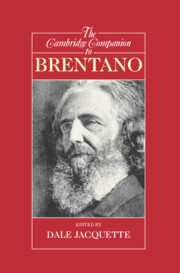Book contents
- Frontmatter
- 1 Introduction
- 2 Brentano’s relation to Aristotle
- 3 Judging correctly
- 4 Brentano on the mind
- 5 Brentano’s concept of intentionality
- 6 Reflections on intentionality
- 7 Brentano’s epistemology
- 8 Brentano on judgment and truth
- 9 Brentano’s ontology
- 10 Brentano’s value theory
- 11 Brentano on religion and natural theology
- 12 Brentano and Husserl
- 13 Brentano’s impact on twentieth-century philosophy
- Bibliography
- Index
8 - Brentano on judgment and truth
Published online by Cambridge University Press: 28 May 2006
- Frontmatter
- 1 Introduction
- 2 Brentano’s relation to Aristotle
- 3 Judging correctly
- 4 Brentano on the mind
- 5 Brentano’s concept of intentionality
- 6 Reflections on intentionality
- 7 Brentano’s epistemology
- 8 Brentano on judgment and truth
- 9 Brentano’s ontology
- 10 Brentano’s value theory
- 11 Brentano on religion and natural theology
- 12 Brentano and Husserl
- 13 Brentano’s impact on twentieth-century philosophy
- Bibliography
- Index
Summary
INTRODUCTION
It is well known that Brentano classified “psychical phenomena” as presentations, judgments, and phenomena of love and hate. Presentations are presentations of objects, although their objects may not exist. One might say roughly that presentations are the vehicles of content, but a presentation is not propositional in form and does not embody any stance of the subject toward the content in question. Judgments are affirmations or denials of presentations. Thus they are based on presentations but are not a species of them. It is of course judgments that are true or false. Phenomena of the third class are also based on presentations, and, like judgments, also embody a stance of the subject toward the content in question. Brentano sometimes characterizes this as Gefallen oder Missfallen, which might be rendered roughly as a pro- or con-attitude. Such attitudes can also be correct or incorrect, an idea that is the starting point of Brentano's ethics. However, phenomena of love and hate will play almost no role in what follows. The three-fold classification is presented in Psychology from an Empirical Standpoint in 1874 and Brentano held to it for the remainder of his career.
- Type
- Chapter
- Information
- The Cambridge Companion to Brentano , pp. 168 - 196Publisher: Cambridge University PressPrint publication year: 2004
- 5
- Cited by



